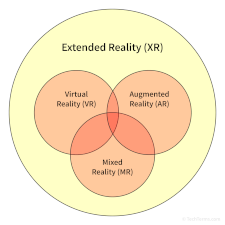Extended Reality
Extended reality, abbreviated "XR," is an umbrella term for technologies that replace or augment the real world with a computer-generated simulation. It encompasses the three immersive technologies of virtual reality (VR), augmented reality (AR), and mixed reality (MR).
- Virtual reality fully immerses a person in a digitally-simulated environment. Users of virtual reality wear a special headset, or HMD, that fully blocks out their surroundings. A VR headset allows people to experience either 360º video or a fully-computer-generated setting.
- Augmented reality overlays computer-generated imagery on a real-world environment. AR uses a smartphone or other camera to analyze a person's surroundings, then displays the real-time video feed with additional imagery superimposed.
- Mixed reality is similar to augmented reality, blending real and virtual worlds together. It supports more interaction between the real and virtual worlds than augmented reality. For example, an augmented reality game may show a virtual character standing in a real environment. In a mixed reality game, that character could interact with its surroundings by hiding behind a real object.
As new kinds of immersive technologies emerge, they will exist under the umbrella term of extended reality. For example, current XR technologies only utilize two human senses — sight and hearing. Future technologies could include simulation for other senses like touch, taste, and smell.
 Test Your Knowledge
Test Your Knowledge